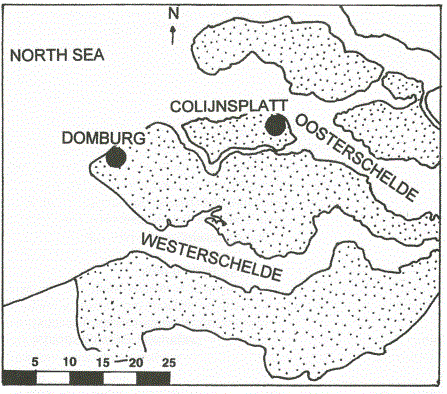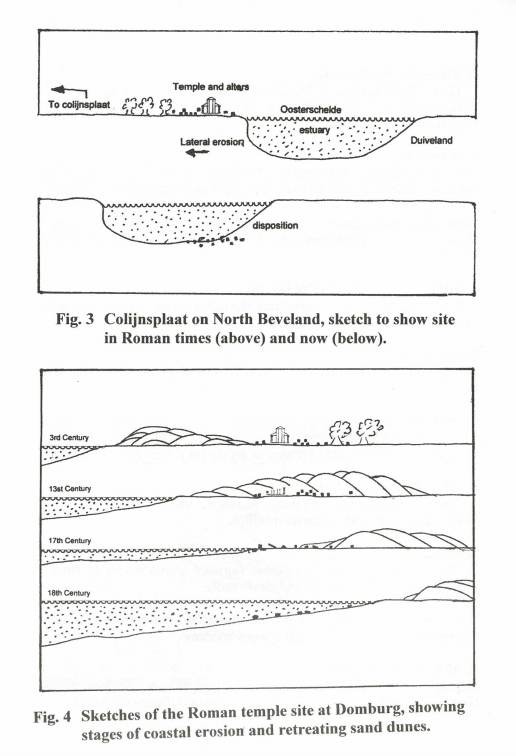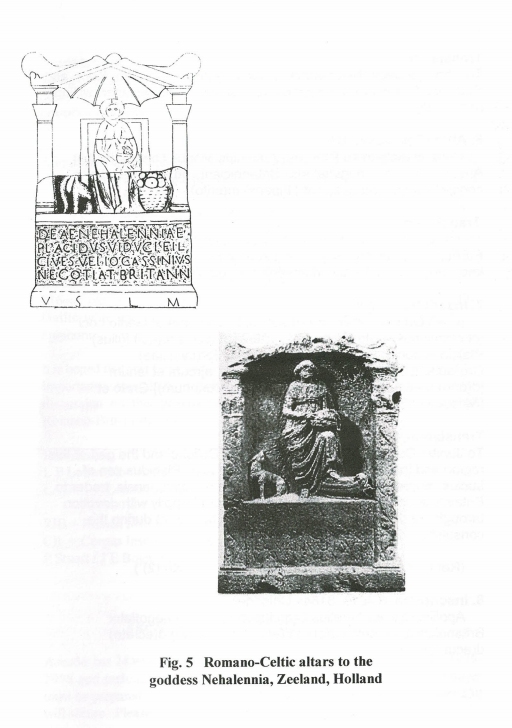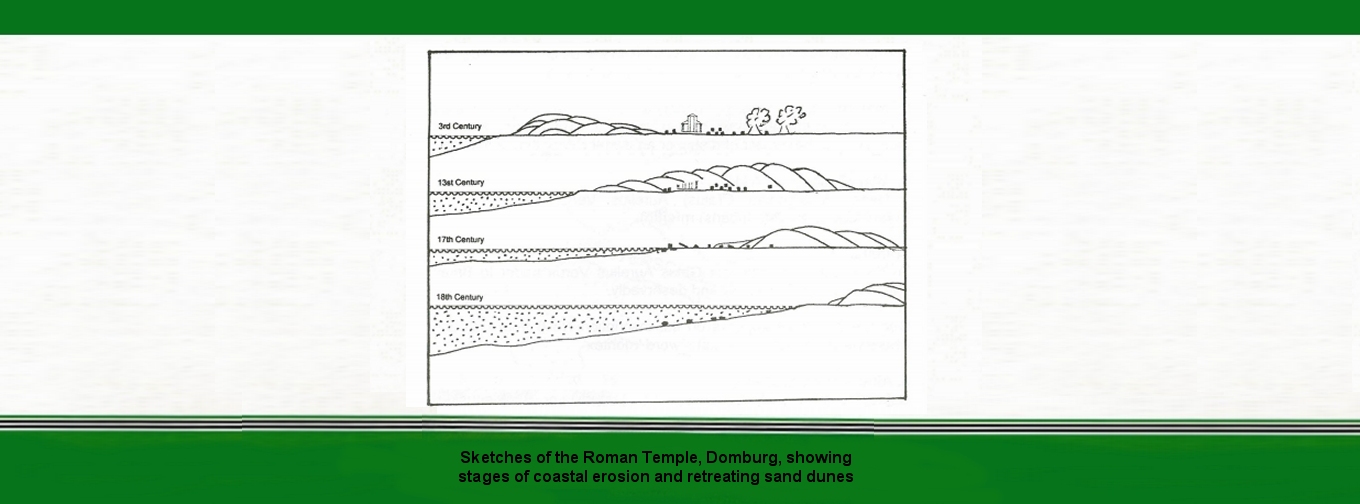ROMAN TEMPLES AND ALTARS FROM HOLLAND
Gerald B Clewley
Some discoveries of Roman altars from Holland are of interest and importance, but seem to be largely unreported in Kent, even though they may have considerable local relevance.
As early as the 17th century, a large number of stone altars were found on the beach near the town of Domburg (Fig. 1). These had presumably been washed out of the sand dunes by a severe storm in 1647 which had hit the peninsular of Walcheren, in the Dutch province of Zeeland. Many of these were dedicated to the Gallo-Roman Goddess Nehalennia. Regrettably nearly all were destroyed in a fire in 1848.
In April 1970, a fisherman trawling at a depth of 25m near Colijnsplaat (North Beveland) in the East Scheldt estuary in Holland, found several similar altars. A number were complete and measured between 28 and 143cm in height. They were of limestone and dated no later than 280AD, and again depicted the Goddess Nehalennia. The sites near Colijnsplaat and Domburg are about 24km (15 miles) apart. Somewhere between the two sites was the lost settlement of Ganuenta. This port has since disappeared beneath the waves and now lies somewhere at the bottom of the Scheldt estuary (Fig. 2). It was probably the capital of the Fresians.
Later in 1970, the National Museum of Leiden, Holland, organised a systematic search in the Oosterscheldt, and during August and September recovered another 101altars and three statues. Many of these are now in the Rijksmuseum van Oudheden, Leiden and the Zeeland Museum, Middleburg, Holland (see L P Louwe Kooijmans).
Many of the altars recovered display the image of the same Goddess Nehalennia, seated in an armchair set in a niche, with a dog to her right and a basket of fruit (probably apples) to her left. Other images show her holding a basket of fruit on her lap. She was a goddess of the Celtic tribes, the Fresiavones, and was invariably associated with the sea and much venerated by the early Romans. She was probably a guardian of travellers or a protector of seafarers. She certainly seems to have been a goddess for the protection of passage across the sea, and indeed both Domburg and Colijnsplaat are on the coast.

Fig. 1 Location map showing main rivers and towns mentioned in text.
Of the many votive altars that I have found, I have selected just six and two inscriptions, as these have a particular relevance for Britain and its naval and seafaring trade. There is every chance that the majority of ships sailing from Domburg and Colijnsplaat were trading with Britain across the North Sea. In the section which follows, note that all translations are provisional.
ALTAR INSCRIPTIONS
- Altar. (Colijnsplaat A3)Deae N[e]halennia / ob merces recte conser/vatas M(arcus) Secund(inius?) Silvanus / negotiator cretariu[s] Britannicianu[s] v(otum) s(olvit) I(ibens) m(erito).
Translation
To the goddess Nehalennia for the good protection of the merchandise, Marcus Secundinius Silvanus merchant trading in pottery to Britain, willingly deservedly fulfilled his vow.
Comment - We do know that the Secundi family came from near Trier where a monumental tomb was erected, standing 23 metres high, made of red sandstone, (The Hedgehog) the resting place for 2 brothers Lucius Secundinius Aventinus and Lucius Secundinius Securus. At the base of the column is a relief showing the manufacture of pottery. The implication is that Secundinius was making earthenware somewhere in East Gaul between Cologne and Trier. Then shipping it down the rivers Moselle and Rhine stopping at the Schelde estuary and visiting the temple of Nehalennia and then on to Britain, probably Portus Dubris - Dover, as one of the inscriptions (No. 5) indicates.

Fig 2. Location map of Domburg and Colijnsplaat, Zeeland, Holland.
- Altar. (Colijnsplaat A6).
Deae Nehalenniae / Placidus Viduci fil(ius) / cives Veliocassinius negotiate(or) Britann(icianus) / v(otum) s(olvit) libens) m(erito).
Translation
To the goddess Nehalennia, Placidus Viduci son, citizen of Veliocassinius, trader to Britain, willingly deservedly fulfilled his vow.
Comment - Veliocassinius was an area around Roman Rotomagus
Rouen. Viducus is believed to be a Celtic name. (See also inscription
No (7)).
- Altar. (Stuart-Bogaers Cat No 13). Deae Nehalenniae / Vegisonius Mar/tinus cives / Secuanus nauta /v(otum) solvit) I(ibens) m(erito).
Translation
To the goddess Nehalennia, Vegisonius Martinus citizen of Sequani, merchant trader, willingly deservedly fulfilled his vow.
Comment Vegisonius is probably a Celtic name. Sequani were a
Celtic tribe in the region of Roman Vesontio = Besançon. Nauta is more likely to be master of a ship or an owner rather than a mariner.
- Altar (Colijnsplaat A11). Deae Nehalenniae C(aius) Aurelius Verus negotiator
Britannicianus ex veto l(ibens) m(erito).
Translation
To the goddess Nehalennia Gaius Aurelius Verus trader to Britain (placed this altar?) willingly and deservedly.
Comment - Verus appears on the inscription No 8 from Cologne, where we come across the Latin word 'moritex'.
- Altar (Colijnsplaat A9).
De[ae] Nehalenni[ae] [] Val(erius) Mar[] negotiator) Canftianus) [et] Geserecan [us] ob merces bene clons(ervatas) I(ibens) m(erito)].
Translation
To the goddess Nehalennia Valerius Mar... trader to Kent and Boulogne for keeping the merchandise safe (placed this altar) willingly deservedly


- Altar (Colijnsplaat B10). Deae Nehalenniae P(ublius) Arisenius Marius libertus P(ubli) Ariseni V. Thi negotiatoris Britanniciani ob merces bene cons[e]rvata[s v(otum s(olvit)] I(ibens) m(erito).
Translation
To the goddess Nehalennia, Publius Arisenius Marius, ex-slave? of Publius Arisenius son of V...hus, trader to Britain, for the merchandise, keep very safe, willingly deservedly fulfilled his vow,
- Inscription (York)
[I(ovi) O(ptimo M(aximo) A(eterno) D(olicheno) et Genio Loci [et n(uminbus) Au]g (ustorum) L(ucius) Veducius [L(uci) f(ilius) Placidus domo [civit(ate)] Veliocas[s]ium [pr(ovinciae) Lug(dunensis) negotiator [Brit(annicianus) a]rcum et ianum [d(ono) d(edit) I(oco) d(ato) d(ecreto) [d(ecurionum)] Grato et [Seleuco co(n) s(ulibus)].
Translation
To Jupiter Optimus Maximus Aeternus of Doliche and the god of this region and the divine emperor, Lucius Viducius Placidus son of Lucius, citizen of Velocasses in the province Lugdunensis, trader to Britain's stronghold.........gave and dedicated happily with devotion through the decree of the councillors (of Eboracum) during the consulship of Gratus and Seleucus.
(Ref to Placidus from Velocasses. See altar No (2)).
- Inscription. (CIL13, 8164a Cologne) Apollini C(aius) Aurelius C(ai) I(ibertus) Verus negotiator Britannicianus moritex d(ono) d(edit) I(oco) d(ato) d(ecreto) d(ecurionum).
Translation
To Apollo, Gaius Aurelius. Verus freedman of Gaius, trader to Britain, gave and dedicated happily with devotion through decree of the councillors (of Cologne).
After searching through more the 500 Roman inscriptions I have not been able to find a precise example for the translation 'd d 1 d d d' which appears on a coffin inscription (No. 7) from York and on an inscription (No. 8) from Cologne. Moritex, or moritix, does not seem to be an obvious Latin word. My research has only brought to light three examples. (1) Londiniensium inscription now in the Cuming Museum, London suggests shipper of wine or wares. (2) (LAOCT, 144. RIB 678, York), implies that Diogenes whose name appears on the inscription may well be a rich wine merchant from Aquitania. (3) (CIL 13, 8164a Cologne) (see inscription No. 8). It is known from classical literature that Gallic wine was being transported to Britain in wooden barrels and not in amphora.
It is hoped that this brief article will draw the attention of Kent scholars to the important votive altars in Holland. I invite them to provide a more serious discussion on this provisional translation and the wider implication for Romano-British studies.
References
LP Louwe Kooijmans, de Nehalennnia-temple te Colijnsplaat (1971). LAOCT London Association of Classical Teachers, Original Records No 4 (1969)RIB Roman Inscriptions Britain. CIL Corpus Inscriptionum Latinarium
P Stuart/JE Bogaers, catalogus van de monumentun (1971)

